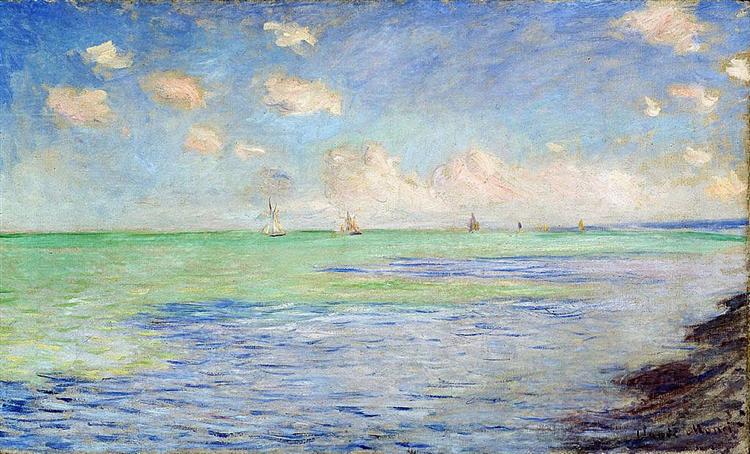Beschrijving
Claude Monet's "The Sea at Pourville" created in 1882 stands as a vibrant testament to the Impressionist movement, a style that advocated capturing light and color in their purest and most ephemeral form. In this painting, Monet invites us to immerse ourselves in his maritime surroundings, where the serenity of Pourville Beach unfolds in all its splendor, symbolizing not only a physical place, but a sensory experience that transcends the visible.
The composition of the work is notable for its focus on the sea and the sky, which intertwine in a dialogue of colors. Monet uses a palette of blues and greens, which represent the vastness of the ocean, and whites and grays that suggest the clouds gently sliding across the sky. This chromatic interplay reflects the instability of natural light, a recurring theme in his work, where different times of day and atmospheric conditions transform the landscape.
In the foreground are tiny human figures that appear vaguely outlined, their silhouettes blending in almost as part of the landscape itself. The lack of detail in these figures is a deliberate choice by Monet, highlighting the vastness of the natural environment over the insignificance of the individual. This can be interpreted as a meditation on the human relationship to nature, a theme that resonates deeply in Impressionism, inviting contemplation rather than narrative.
The painting is dynamic; the brushstrokes are loose and fluid, creating a sense of movement that evokes the movement of waves and the sea breeze. The technique of applying colour in thick layers of paint can be seen as an early precursor to the techniques he would develop later in his career. In "The Sea at Pourville", Monet shows complete mastery of oils, achieving an almost tactile effect that invites the viewer to feel the salty breeze and the sound of the waves.
An interesting aspect of this work is its historical context. Painted during one of Monet's stays on the Normandy coast, this work was part of a period in which the artist concentrated on capturing natural light and the fluid textures of water. Monet continually experimented with capturing light in his landscapes; "The Sea at Pourville" is a manifestation of his constant search for the representation of atmosphere and moment. This painting, in particular, can be seen as a first step towards his famous works from his Water Lilies series, where water and light become absolute protagonists.
Ultimately, The Sea at Pourville is not only a magnificent example of Monet’s technical prowess, but also a reflection of his deep bond with nature. His ability to translate the subtleties of the environment into an accessible and exciting visual language is what has secured him a place as one of art’s greatest masters. Looking at this work, we are reminded not only of the beauty of the Normandy coast, but also of the inescapable connection between man and the world around him – a fundamental principle in Impressionist practice and in Monet’s enduring legacy as an artist.
KUADROS ©, a famous painting on your wall.
Hand-made oil painting reproductions, with the quality of professional artists and the distinctive seal of KUADROS ©.
Painting reproduction service with satisfaction guarantee. If you are not completely satisfied with the replica of your painting, we will refund 100% of your money.

